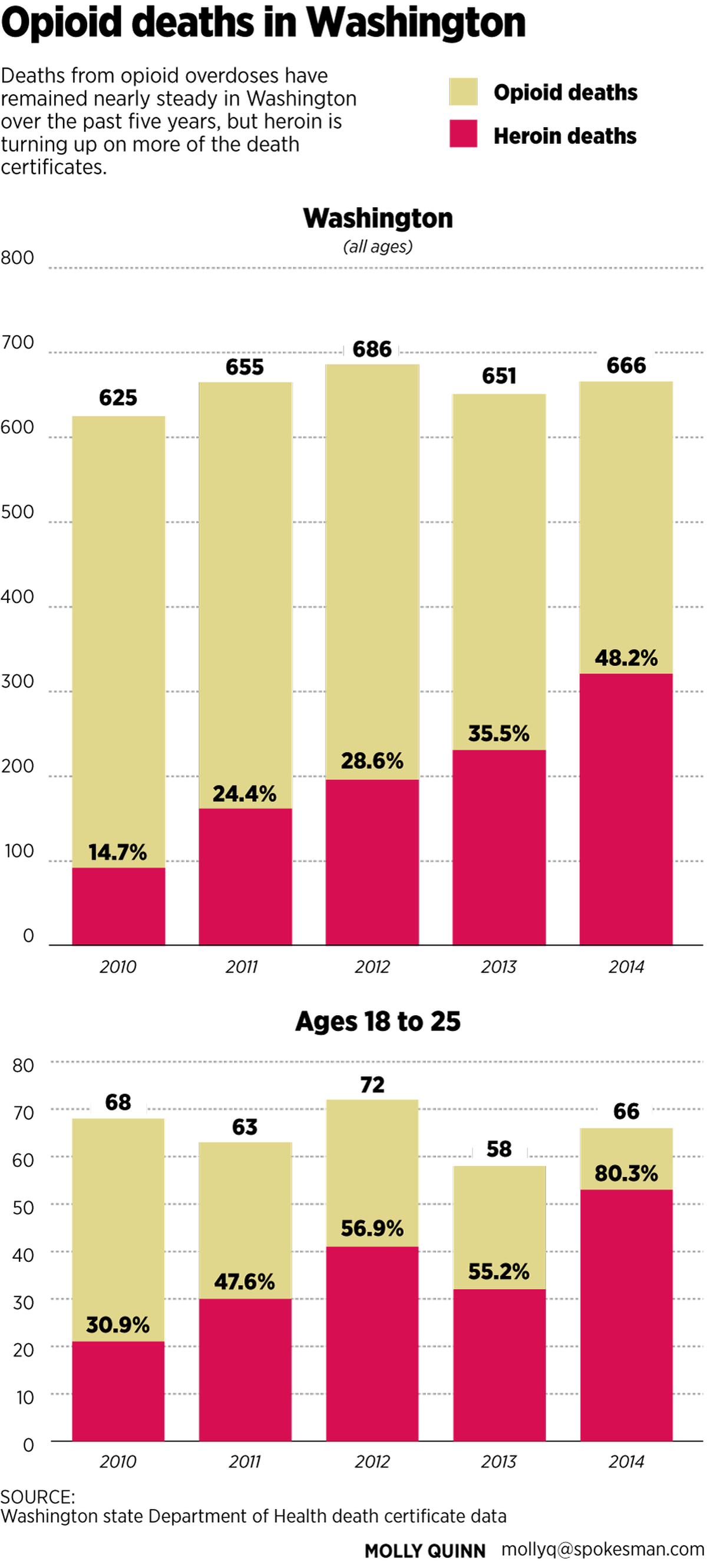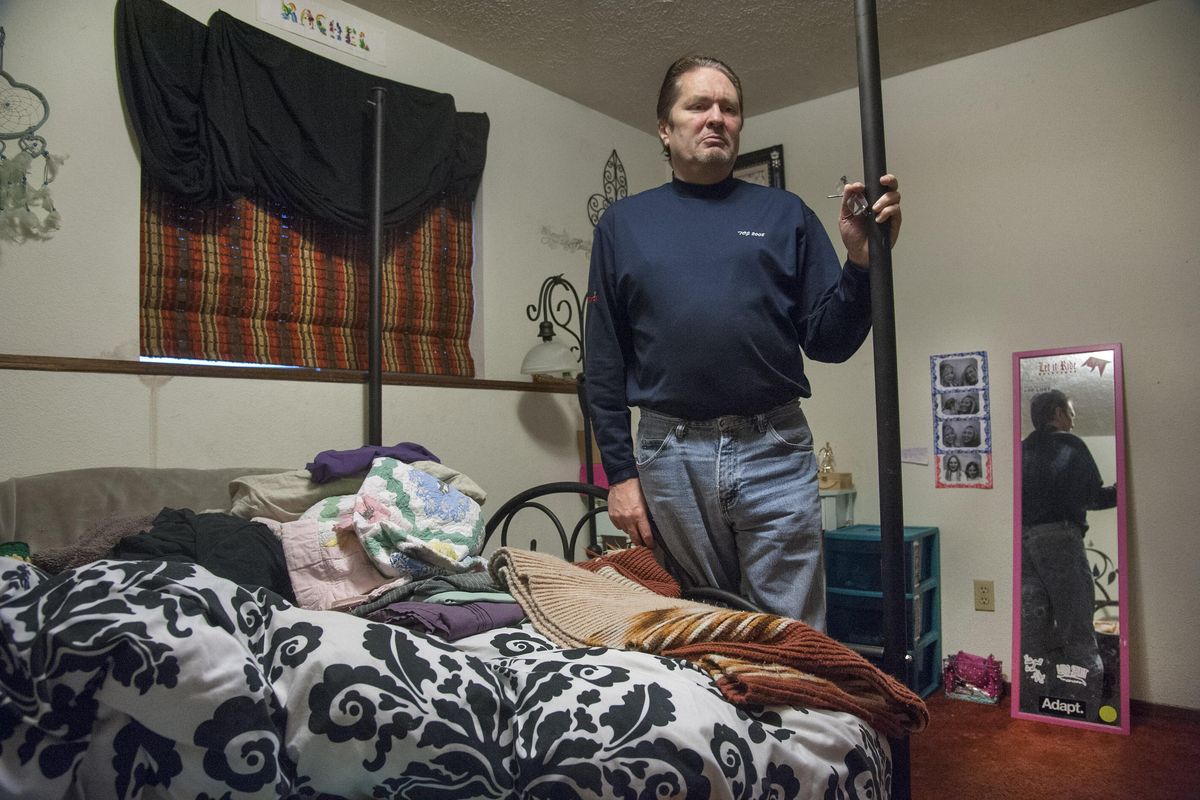Heroin epidemic in Washington: Father wants state to help parents confront addiction
Scott Meyers’ daughter, Rachel, died of a heroin overdose in March 2015. He’s trying to get a law passed to make it easier for teenagers to be involuntarily committed for drug treatment. Meyers has kept her room in his Mead-area home the same since her death. (Dan Pelle / The Spokesman-Review)Buy a print of this photo
The phone call Scott Meyers dreaded came in the early hours of a Monday last March.
His 18-year-old daughter, Rachel Meyers, had spent a year bouncing in and out of treatment for heroin addiction. Police had arrested her several times and she had survived multiple overdoses.
But things seemed to be looking up.
After a tumultuous period living with her boyfriend in a drug house, she was back home and clean for six weeks, her father said. She had just started going to a new outpatient treatment program.
His fleeting hopes ended on a Saturday when Rachel brought her boyfriend home. Meyers knew he had sold Rachel drugs in the past and told her he couldn’t stay.
The two fought and Meyers ended up kicking her out.
At 4 a.m. on Monday the phone rang. Rachel had overdosed again at her grandmother’s apartment. This time she didn’t wake up.
When Meyers arrived he gently pulled back the blanket draped over her body and leaned in to give his daughter one last kiss. Rachel’s green eyes were still open.
“That’s going to haunt me forever,” he said.
Washington has been in the midst of a heroin epidemic since at least 2013, according to public health officials and law enforcement. Across the United States, numbers associated with heroin have been on the rise since the mid-2000s: more DEA seizures of the drug, more overdoses, more demand for treatment beds.
Especially grim are Washington death records.
In 2010, there were 92 people who died of opioid overdoses with heroin listed on their death certificate. Four years later that number had more than tripled to 321, with heroin surpassing methadone and oxycodone as the leading drug blamed in fatal overdoses.
Rachel’s death rearranged Meyers’ life, sending him headlong into a severe depression and a search for answers. One year ago, he was busy looking into treatment programs and trying to persuade police to arrest his daughter so she’d be forced to get help.
“I tried getting her committed, I tried getting her thrown into jail – anywhere I could account for her,” he said. She started a program in Yakima but walked out. When she overdosed on multiple occasions, she went to the hospital and was released soon after stabilizing. Once, in desperation, Meyers lied to first responders and said he thought Rachel tried to commit suicide by overdosing.
Even that wasn’t enough to hold her against her will.
Currently, teenagers can refuse treatment
Though it’s too late for his own daughter, Meyers is focused on making sure other parents don’t have to suffer the grief that’s been with him since that March night. He’s worked with Spokane Valley Rep. Matt Shea to introduce a bill he’s calling Rachel’s Law, which would allow parents or guardians to put their minor children in drug treatment for up to 14 days. Right now, teenagers 13 or older can refuse treatment.
Part of the problem is that Washington has no secure beds for detox or drug treatment.
“There is supposedly an involuntary treatment option for addiction, but it’s not really involuntary because if they want to leave they can walk out,” said Dr. Matt Layton, a psychiatrist specializing in substance abuse who teaches at Washington State University Spokane and serves as medical director for the Spokane Regional Health District’s opioid treatment program.
Annette Klinefelter, executive director of Daybreak Youth Services, an addiction treatment program for young people based in Spokane, said programs for teens don’t let teens leave the facility without trying to stop them and calling their parents.
Even for someone who wants treatment, getting a bed is difficult. Voluntary rehab programs can have long waiting lists. For a parent who wants to make sure their child isn’t using, locking a teenager in jail sometimes feels like the only option.
“You can’t get your kid admitted into treatment right now,” Klinefelter said. “Your best hope is that they get arrested and that they’re court-mandated to attend treatment, and that comes with a tremendous number of long-term consequences.”
Rachel’s Law is unlikely to pass this session. The bill has no co-sponsors, was never scheduled for a hearing and missed a Feb. 17 deadline to be passed by the House and sent to the Senate for review. Shea spokesman John Sattgast said the Republican representative still is committed to pushing the bill forward and believes it would save lives.
Another bill with a similar goal passed the House last year but failed after amendments in the Senate regarding budget concerns. The bill, named “Ricky’s Law” for a Seattle man who struggled with heroin addiction for two years before getting clean, was reintroduced this session and passed the House again last week.
Ricky’s Law would combine the state’s involuntary commitment systems for mental health and substance abuse, making it easier for people of any age to be involuntarily committed for drug treatment by court order. Parents also could request a commitment hearing for their minor children. It was introduced by Rep. Eileen Cody, D-West Seattle, and sponsored by other Democrats, though it passed the House with bipartisan support. Shea and 14 other Republicans voted against the bill.
Cody said in response to budget concerns raised last session that she extended the timeline for opening new detox facilities under Ricky’s Law so costs are spread out over a longer period. It’s estimated to cost $6 million over two years and $14 million for the following two years. The House has the money in its budget, she said, and preventing more deaths should be a priority.
“We can only bury our head in the sand for so long,” she said.
Heroin leads the list for opioid overdoses
Statewide, deaths caused by opioid overdoses, including heroin, methadone and prescription drugs like oxycodone, remained roughly steady from 2010 to 2014, peaking at 686 deaths in 2012, health department data shows.
The data lists every drug recorded on the death certificate where the underlying cause of death is an opioid overdose, so the fact that heroin is listed on a certificate does not mean it’s the sole cause of death. But over the past few years, it’s been turning up more and more.
In 2010, heroin was listed on the death certificate for about 15 percent of total opioid overdoses in Washington, trailing behind methadone and oxycodone. By 2014, heroin was leading the list, with nearly half of the total. The numbers are especially bad on the west side of the Cascades. King County had 139 heroin-related overdoses in 2014, which gave it a per-capita death rate nearly three times Spokane County’s.
Heroin seizures are up, too, the DEA says. The agency issued a “threat assessment” report on heroin last year, which found heroin seizures nationwide have nearly doubled from 2010 to 2014. Many DEA regions, including Washington, now report the drug as their No. 1 problem.
The Northeast and Midwest are the hardest-hit areas, the report says. In some Northeastern cities, opioid overdoses have surpassed car accidents as the leading cause of accidental death, Spokane-based DEA Special Agent Tracy Simmons said. But Washington and Idaho are seeing the effects, too, as cheap black-tar heroin, mostly imported by the Mexican Sinaloa drug cartel, makes its way across the border through Arizona and California.
“They’re pushing so much of it that it’s driving the price down,” Simmons said.
Heroin is a particularly dangerous drug, the DEA report notes. The number of people using prescription pain medication without a doctor’s order is about 15 times the number using heroin, but prescription medications account for only twice as many overdose deaths.
In Washington, few of the dead are under 18, but once young people become legal adults, those numbers start to rise. Heroin is listed on the death certificate for 80 percent of Washington adults under 25 who died of an opioid overdose in 2014.
Prescription drugs to heroin a common path
Like many teenagers, Rachel Meyers started smoking marijuana in high school. By the time she was 16, she was stealing prescription medications.
Meyers has tried to make sense of the pain that led his daughter to turn to drugs. She was raped at 16 by a friend’s father while attending a concert, he said, though he didn’t find out about the assault until more than a year later. Meyers called police to report it and was told it would have to be handled in Grant County, where the rape occurred, and that the odds of conviction were poor because Rachel didn’t have a rape kit done at the time.
Rachel also was dealing with the aftermath of her parents’ divorce, which ended with Meyers getting sole custody of her and his other daughters. As the middle child, she sometimes felt overlooked, even abandoned, he said.
Meyers first learned his daughter had a problem when she fell asleep at the wheel after taking nine pills of the sedative Ativan and hit a light pole on Division Street going 55 mph.
Sometime in the next year, Meyers knows his daughter started using prescription opioids. She was stealing pain pills from her grandmother, then taking other valuables from Meyers and her grandparents to buy drugs. By the summer of 2014, Meyers noticed Rachel was wearing long-sleeved shirts in hot weather. He confronted her and found track marks and bruising on her arms. She told him she was crushing the pills and shooting them up.
At some point, pills became too expensive, he said. Rachel, like many teenagers, realized she could get the same high for less money by switching to heroin.
Layton said that’s a common pattern.
“Teenagers bypass the liquor cabinet for the medicine cabinet and then they start to get to where they’re using all the time,” he said. When they run out of medication to steal from family members, they might try to buy prescription pills on the streets. But those drugs have become more expensive while the price of heroin has fallen.
People who have been using for a while start to go through withdrawal as their bodies adjust to the dosage, Layton said. That means young people who start using prescription opioids in high school may turn to heroin in their late teens or early 20s. Some misjudge the dosage. Some overdose after they’ve been clean for a while and try to go back to the amount they were taking before.
The health department’s 2014 data lists 53 adults under 25 who died in Washington from a heroin-involved overdose. Three-quarters of them are men.
A 24-year-old Bellingham man left behind a wife and three children, his obituary in the Lummi Nation’s newsletter says. There’s a 21-year-old barista from a town near Aberdeen who smiles at the camera in her obituary photo, her blond bangs swept over one eye. In Spokane, heroin is on the death certificate of a third-generation Gonzaga University student with an academic scholarship who was hoping to study history.
Rachel’s name will be on the 2015 list. Her death certificate will say heroin. What it won’t say: Mt. Spokane High School honor student; Humane Society volunteer; mother to her pit bull, Sophie; soccer and volleyball player.
“Junkies are somebody’s kids,” Meyers said.
New approaches require more funding
Helping them will take a commitment from the state to fund more beds for treatment, Klinefelter said. Right now, a teenager who overdoses will be treated at the emergency room. If they’re considered to be a danger to themselves or others, they may be transferred to a children’s hospital, then sent to a program like Daybreak if bed space is available.
On any given day, 80 teens are waiting for a bed at Daybreak facilities in Spokane and Vancouver, Washington. More often, teens who overdose are simply stabilized and released.
“We don’t have nearly enough capacity in the system,” Klinefelter said. If Rachel’s Law passes, she said, a minor would be transferred to another bed for evaluation and treatment after an overdose to figure out what type of treatment would help. Ricky’s Law would have people evaluated by a mental health provider in a detox facility.
“Both have significant merit,” she said. But either law would need a commitment to fund more beds so people can be evaluated and treated.
Meyers started working on Rachel’s Law after Ricky’s Law failed to pass last year. He said Rachel’s Law might be easier to pass in a climate where dollars are scarce because it only addresses commitment for minors and would require fewer resources to implement.
Rachel’s Law is “an immediate solution; it will immediately start saving lives,” Meyers said. But he’d be happy to see either bill pass and said the issue should be nonpartisan. Anything to stop people dying from heroin overdoses.
Meyers has been on a leave of absence from his job as a railroad contractor since Rachel died. He’s dedicating himself to advocacy work and has started the Rachel Meyers Foundation, which is advocating to get his law passed in Washington and other states that allow minors to refuse treatment, including Idaho. He’s also planning to speak at schools and has become an informal resource for teenagers who are struggling to kick heroin addictions.
Nearly a year after her death, Meyers can now talk about Rachel without crying, but his words come weighted with grief.
“I hold myself responsible for the whole thing because I didn’t find a way to get her the help she needed,” he said.
Meyers’ youngest daughter is a teenager who still lives at home, and his oldest is an adult who has moved out of the area. He knows Rachel’s death and his new focus on heroin recovery and involuntary treatment has been hard on them. Sometimes, he said, they remind him that he still has two living children.
He’s left Rachel’s room the way she had it before she died. She’d just finished rebuilding a canopy bed and decorating it the way she wanted. On her wall, a strip of photo-booth pictures with her sister hangs next to a handwritten reminder about her next court date.
Meyers knows Rachel is never coming home again, but he still leaves the front porch light on at night.
“If I knew how things were going to end up … if someone had given me a magic wand and said, ‘OK, you can have a choice of never having her or having this happen and having to go through all the pain,’ as terrible as this was I’d do it again,” he said. “I love her, loved her … I was blessed to have her in my life as long as I did.”




